Lippingcott's Monthly Magazine
One of the most successful magazines in North America
Lippincott's Monthly Magazine was a 19th-century literary magazine that cleverly managed to attract well-known authors as well.
The magazine was published in Philadelphia from 1868 to 1914 or 1915 (sources unclear), later moved to New York and was renamed McBride's Magazine. In 1916 it merged with Scribner's Magazine.
The magazine was edited by Joshua Ballinger Lippincott (1813 - 1886) and was published semi-annually. Lippincott founded the publishing house J.B. Lippincott & Co. in Philadelphia, Pennsylvania in 1836 at the age of 23. Initially, the publishing house published Bibles and prayer books, but quickly expanded its spectrum to include history, biographies, fiction, poetry and gift books, and later added almanacs (annually published reference books on a subject), medicine and law, textbooks and dictionaries. Lippingcott, together with his wife Josephine C. Craige Lippincott (pictured ), had three children, Walter Lippincott (1849-1927), Joshua Bertram Lippincott (1857-1940) and Craige Lippincott (1846-1911) Source: https://de.findagrave.com/memorial/78392257/craige-lippincott. Craige ran the publishing house until his tragic death in 1911.
The Philadelphia-Feed
Lippingcott and the Duke of Buckingham
Joshua Ballinger Lippincott can be counted among the great publishers of the 19th century USA. He had excellent connections and was even once invited to the country estate of the third Duke of Buckingham, at Stowe House, Buckinghamshire. At least that's the story he told the Philadelphia Times reporter. The Iola Register and other newspapers printed this story in 1886.
Mr. Lippincott told me how he once entertaineal the Duke of Buckingham.
It happened in this way. When Robert Chambers visited the United States some years since I gave a dinner in his honor. The Duke of Buckingham happened to be stopping at the Continental Hotel at the time, and hearing of the affair that was to come off he signified his desire to me to be present at a genuine Philadelphia 'feed.' Of course he was invited and sat down, as he told me afterward, to the most elegant entertainment he had ever enjoyed. There were present at the dinner the Governor of Pennsylvania, the Mayor of Philadelphia, and the most distinguished men of the day to the number of one hundred. When I next visited England the Duke invited Mrs. Lippincott and myself to Stowe, where my wife remained two weeks. Stowe is one of the most magnificent seats in Great Britain, the house two hundred feet long, the grounds an earthly paradise, everything on a scale of royal splendor; in fact, I doubt whether roralty itself has a more sumptuous domain than the princely Duke of Buckingham. I highly appreciated the honor of being invited to the Duke's seat, where an English publisher's horse would as soon be invited as himself.
Form ever follows function
The American architect of the 19th century
Henry Louis Sullivan
In my first status report, I try to trace the origins of Louis H. Sullivan's design maxim "Form ever Follows Function" and decipher its true meaning. What did Sullivan really mean and in what context did the essay with the meaningful quote originate?
Why a blog post about an American literary magazine? First of all, because I didn't want to deprive you of the beautiful covers. Secondly, because the American architect and essayist Louis Henry Sullivan published his famous essay on the American skyscraper in the spring issue, number 57, on 23 March 1896. It was entitled » The tall office building artistically considered « and contained what is probably the best-known, most frequently quoted and most misunderstood design maxim of the 20th and 21st centuries, » Form ever Follows Function «. Louis H. Sullivan is considered the architect of the 19th century. His work shaped the view of Chicago and other cities in North America for decades, he influenced generations of architects, most notably Frank Lloyd Wright, another American master of architecture. More on this in my status report with the same name.
Doyle und Wilde
Famous poets' meeting
On 30 August 1889, a memorable meeting of poets took place at the Langham Hotel, corner of 1c Portland Place, Regent Street, London. The London agent of Lippincott's Monthly Magazine J. M. Stoddart had managed to bring two of Britain's most famous poets to the same table for dinner. Stoddart had already published the memoirs of General Robert E. Lee in 1886. They were Sir Arthur Canon Doyle, only thirty years old, and the thirty-five-year-old writer Oscar Wilde, who, as Canon Doyle later noted, was already famous as a champion of aestheticism. Canon Doyle had also already published a number of books, in addition to the historical adventure novel Mica Clarke, and his first Sherlock Holmes novella » A study in Scarlet «, which had been published in Beeton's Christmas Annual in 1887. Also at the table was Thomas Patrick Gill, a prominent member of the Irish Parliamentary Party. Stoddart had come to London specifically to find authors for his American publisher, J. B. Lippincott, and he succeeded.
First, in February 1890, the Philadelphia magazine finally published » The Sign of the Four «, Canon Doyle's second Sherlock Holmes novel. In this novel about men who are killed for treasure, Dr Watson meets Miss Mary Morstan, Watson's future wife. Stoddart had to wait another 7 months for Wilde's story, and so it was not until July 1890 that Oscar Wilde's " The Portrait of Dorian Gray «, a work of so-called Gothic literature, appeared in Lippincott's Monthly Magazine. Wilde's famous philosophical novella is about Dorian Gray, who sells his soul so that not he but a portrait painted for him will age.
You can read more about this exciting story on Crimereads. I found the story via Insidehook.com..
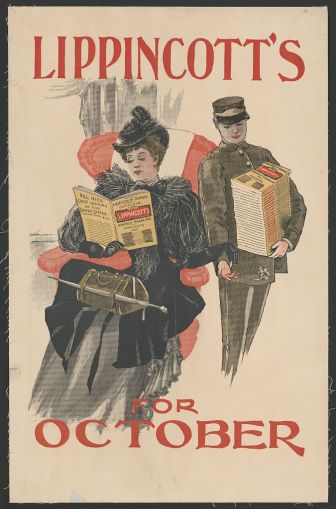
(1894) Lippincott's for October. , 1894. [Philadelphia: publisher not identified] [Photograph] Retrieved from the Library of Congress, https://www.loc.gov/item/2014650203/
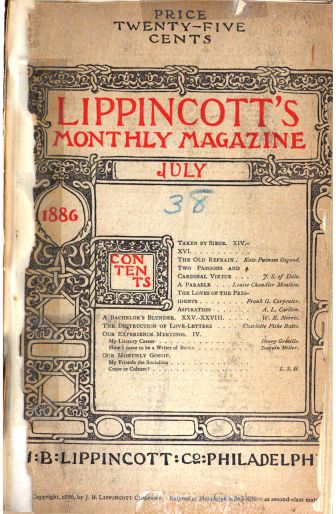
July 1886 edition, note the different layout and how much more effective the area later filled in red is. And note the use of the word Contents for the table of contents.
tl, dr;
A brief outline of Lippingcott's Monthly Magazine, which from Philadelphia brought American and other authors such as Oscar Wilde and Arthur Canon Doyle to an interested audience.


.jpg)
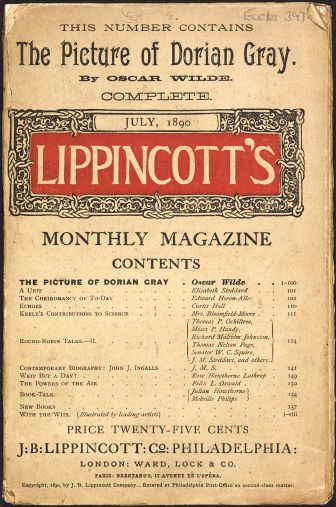

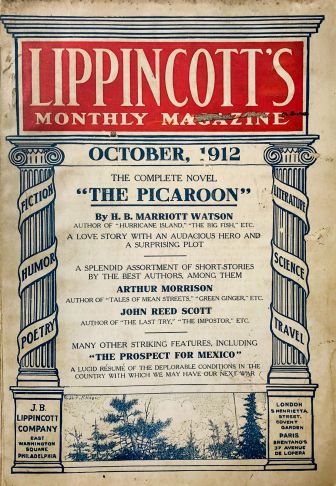

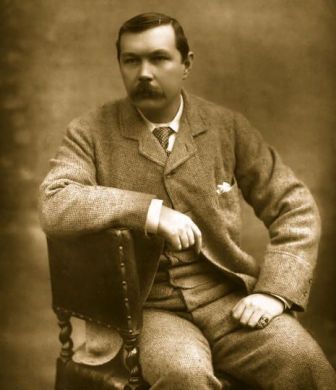
Comments (0)